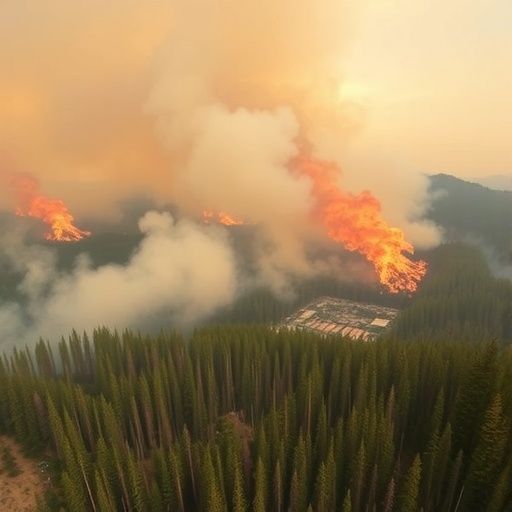In a groundbreaking study published in Global Change Biology on August 20, 2025, researchers unveiled compelling evidence that the severity of wildfires in Northern California’s Sierra Nevada is influenced not only by climatic extremes but critically by the structure and management practices of forests. The findings reveal that industrial private lands, managed primarily by timber companies, are disproportionately vulnerable to high-severity wildfires compared to publicly owned forests. This research sheds new light on the intricate interplay between human land management and wildfire behavior, offering potential pathways for more resilient forest landscapes amid escalating climate challenges.
At the heart of this investigation lies a unique airborne lidar dataset collected just before a sequence of devastating wildfires between 2019 and 2021, including California’s largest recorded blaze, the Dixie Fire. Lidar, or light detection and ranging technology, emits billions of laser pulses to generate fine-scale three-dimensional representations of forest canopies, understory vegetation, and terrain. By meticulously mapping these pre-fire structures across both public and private lands, the researchers were able to correlate precise forest characteristics with subsequent fire severity patterns, advancing an unprecedented understanding of wildfire dynamics.
The study delineates stark differences in forest composition between industrial timberlands and public forests. Timber companies often engage in plantation forestry, established through clear-cutting followed by dense replanting in uniform grids. This results in homogenous stands with high stem density—trees tightly packed and evenly spaced, resembling matchsticks stacked in neat rows. Under extreme weather conditions, such configurations provide a continuous fuel ladder from the forest floor to the canopy, facilitating rapid vertical fire progression and exacerbating fire intensity.
In contrast, public lands tend to harbor more heterogeneous forest structures due to multifaceted management objectives including recreation, wildlife habitat preservation, restoration, and grazing. These lands frequently possess wider spacing between trees and more discontinuous understory vegetation, which can impede wildfire spread. However, public land management faces its own challenges, including regulatory barriers and litigation that often restrict active interventions such as thinning or controlled burns, which are vital tools for moderating fire risk.
The researchers identified stem density as the most significant predictor of high-severity fire occurrence when combined with extreme weather parameters like high temperature, low humidity, and strong winds. Essentially, even as climate change accelerates the frequency and intensity of extreme fire weather, strategic alterations in forest management—particularly thinning to reduce dense stands—could substantially diminish fire severity. This revelation offers a cautiously optimistic avenue for mitigating some climate-driven wildfire risks through thoughtful land stewardship.
Historical fire suppression policies, dating back to the 1800s, have played a critical role in shaping present-day forest vulnerabilities. Indigenous fire stewardship, which historically employed frequent low-intensity burns to maintain resilient forest mosaics, was effectively outlawed, allowing fuel to accumulate unchecked. The absence of fire as a natural ecological process has fostered overly dense forests laden with ladder fuels, predisposing them to catastrophic high-severity wildfires that devour mature trees and alter ecosystem trajectories.
Within the Plumas National Forest, the study’s focal area, these dynamics are vividly illustrated. Eleven years after the 2007 Moonlight Fire, areas that burned at high severity had mature trees charred from root to tip and were overrun by dense shrubs that further inhibit forest regeneration. In contrast, regions experiencing low-severity fires still retained mature tree canopies with limited understory damage, demonstrating the critical role fire intensity plays in determining forest recovery pathways and long-term ecosystem health.
The implications stretch beyond timber production; they extend to carbon sequestration, hydrological cycles, wildlife habitat integrity, and recreational values. High-severity fires result in substantial carbon release, converting carbon-rich forests into shrublands or grasslands with drastically reduced carbon storage capacity. This shift undermines regional and global efforts to mitigate climate change and threatens biodiversity reliant on contiguous forest habitats, prompting urgent reevaluation of management priorities.
Lead author Jacob Levine highlights the potential for active management to reshape fire outcomes. Thinning operations that strategically reduce both small and mature tree densities can disrupt continuous fuel ladders, making forests less susceptible to crown fires—a notoriously destructive fire behavior form that propagates rapidly and unpredictably through canopies. This underscores the critical need to integrate silvicultural practices with broader climate adaptation strategies.
However, challenges remain. Private industrial lands, motivated by profit and timber yield, may prioritize dense plantation forestry that maximizes economic returns but inadvertently creates fire-prone conditions. Meanwhile, public agencies grapple with diverse mandates and external pressures that often result in conservative management approaches. Effective wildfire mitigation will require coordinated policy frameworks that balance economic, ecological, and social objectives across land ownership boundaries.
Further compounding the issue is the observation that wildfire severity on private lands not only threatens those properties but also poses risks to adjacent areas including wilderness regions, small landowners, and urban interfaces. Such “fire contagion” effects magnify the urgency for cross-jurisdictional collaboration and landscape-scale fire resilience planning.
Ultimately, this study advances a critical understanding of how human decisions shape the wildfire future under climate change. While extreme weather conditions undeniably escalate wildfire risk globally, land management practices offer tangible levers to influence fire behavior on the ground. Adjusting forest density, restoring natural fire regimes, and fostering heterogeneous forest structures emerge as vital strategies for preserving iconic Sierra Nevada forests before they are irrevocably transformed into shrublands.
As wildfires grow increasingly ferocious worldwide, the insights from this research underscore a hopeful yet pressing message: meaningful mitigation is not solely contingent on curbing emissions or climate trends but equally on reshaping how we steward our landscapes today. Without transformative changes in forest management, future generations may inherit a Sierra Nevada that no longer reflects the majestic woodlands we have long cherished.
Subject of Research: Not applicable
Article Title: Extreme Weather Magnifies the Effects of Forest Structure on Wildfire, Driving Increased Severity in Industrial Forests
News Publication Date: 20-Aug-2025
Web References: http://dx.doi.org/10.1111/gcb.70400
Image Credits: Credit: Jacob Levine
Keywords: Wildfires, Forest fires, Droughts, Climate change, Forestry, Logging, Silviculture, Sustainable agriculture, Ecological risks, Habitat loss, Climate change mitigation




